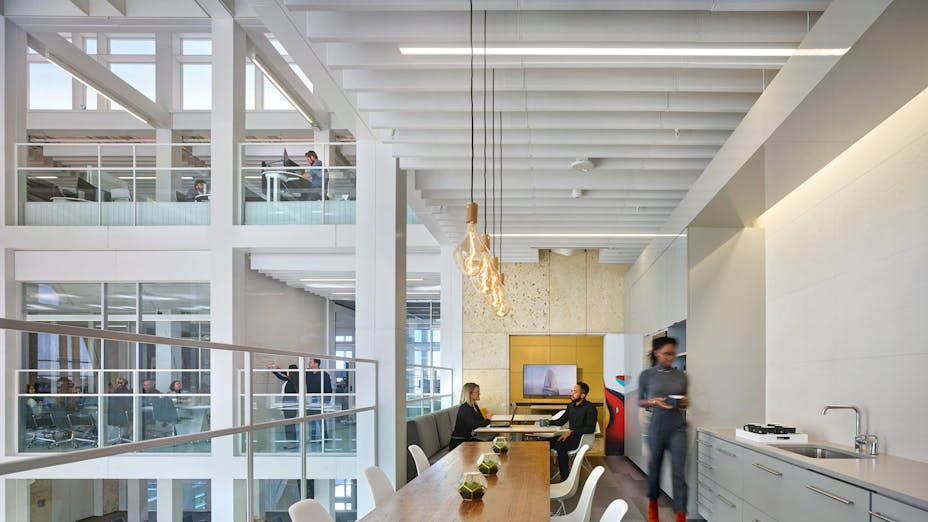Looking at future trends
Due to the global pandemic we've experience the past year, there has been a lot of discussion around what the future of the office space is going to look like. To learn more, we asked architects Helle Nøhr Holmstrøm and Tiago Pereira from Schmidt Hammer Lassen (SHL) about the role of the office space and commercial buildings, workplace trends and material standards, as well as the role of renovation versus new builds.
What do you think the future of office design will be?
TP: There are a lot of articles going around right now about what can happen, or potentially will happen, especially with larger corporations. I think that the future of office design will be more of a collaborative environment where people are going to come together and share amenities.
We are seeing trends for collaborative spaces, learning and performance spaces that are starting to find synergies. We are creating a variety of areas that support different human functions. When we look at the office, employees want to be on their own, but in a social context, and I think that those are some of the exciting things, when you compare them to other typologies like libraries.
What can this place do that we could translate for the workplace as well? We are trying to learn from a variety of building typologies to see how we can support these ordinary, human, basic needs that we have in a workday.
HNH: [The future of the office] is a variety of things. We’ve been talking about this, and we find it interesting to see that when people meet at the office, it will be for the more collaborative side of work.
You will have more areas that support collaboration and more areas that support knowledge sharing because when you’re doing concentration work, you can easily do that from home. It could also be done in a hub, somewhere away from the central headquarters, closer to home. So instead of packing all facilities in one office, companies might look at what facilities makes sense to be productive in a variety of places near the employee’s home area.
But I think the discussion is also about company culture. We don’t see [the future of office] as either-or. It has to be both because you can create a better company culture when you’re together with people.
A lot of companies have done this successfully [working remotely] because they’ve already created a strong and cohesive culture. So, people can still approach each other. The headquarters will still play a role. It should still be seen as a strong focal point for creating a shared culture and supporting social functions and respect for each other. We also need to understand that as people, we are not only working for ourselves, we’re working for a shared purpose. The [office of the future] can vary from company to company, but this is what we need to figure out with the individual business.
One thing that we know is that when people are working, they need to solve problems together and we tend to prefer to solve problems with people we like and know and get along well with. We need to solve problems with people that we trust, and we need to have a place to build that trust.
TP: Empathy and “clicking” with people typically happens when you see someone in person. You look them in the eyes, and there is this human social aspect that only in-person interactions give.
HNH: In most cases, we have better innovation together. There are those that can do it alone, but in general, we reach the best solutions together, and I think that a lot of companies would like to see that happen.
I think that it is a very interesting experiment that we’ve been through. If we don’t use it for our betterment, I think it would be such a shame, because we have this momentum now. Wellbeing is really at the centre of how we should approach projects, and we see a great understanding coming from this that can really benefit people in the long run.
Do you think that the idea of the traditional office space has been changing for some time?
HNH: It has already started to evolve. There has been a desire for this trust and flexibility, but it has been difficult because of a fear of losing productivity.
TP: I would say that the coronavirus only accelerated a trend. What may have been on track to happen over ten years has been accelerated to two years. One could also say there was a very positive acceleration of the “work from anywhere” trend.
Now, we might see employees going to their employers saying that they want more flexibility and it might be that employers reconsider the organisation and ask the question “how can we work differently and more happily?”.
If the office space becomes more of a collaborative hub, with potentially fewer employees daily, do you see existing commercial space being repurposed for other things?
TP: When we relocated to our current office in Aarhus, we were approached by a chef that asked if we would consider having them operate our canteen during the day while also running an independent restaurant in the evening. We thought it was a great idea.
It shows that there is thinking beyond the needs of the office and thinking about the community. If companies can see the synergy, office buildings can be more than just a place where people go between 09.00-17.00. You can share the expenses of a place, which is interesting for property owners because you are paying for the facilities in the evening.
HNH: There is also a respectful element, as well. If you live in a neighbourhood and you live close to an office building that closes at 17.00, you probably don’t have a specific emotion towards that building.
If all of a sudden, that building becomes part of your community, because it is open in the evening or you’re using the building, you develop an emotional relationship with the building because it provides you will something. It becomes an integrated part of how you see what area you want to live in, what amenities you have nearby. It makes us feel safer and more comfortable in our neighbourhood.
What new standards do you see that office spaces should accommodate in the future?
HNH: We do see better hygiene and cleanliness in the workplace. We have to acknowledge that when we don’t really clean our workplace, there is a whole lot of bacteria floating around. So, I think that that is something that we’re going to look into.
When you do interior design in a hospital, you have to use certain kinds of materials because of certain specifications. So this is something that we might start seeing in offices, but not to the same level. There could be a new way of looking at materials that are easy to clean and something that doesn’t attract a lot of bacteria.
TP: There is a lot of focus on natural materials. I think that there is a whole new approach to the material ID. What are their material composition and their sources’ origin? I think that we will see more of that material passport in the future being pushed forwards.
People will share their desks, and people will share spaces, so all the materials that are easy to clean and have more natural materials will have an impact on the choice.
HNH: I think in general we will look at our own office. We have a lot of papers on our desks and a lot of wires under the desk, so it is difficult for cleaners to do a proper job. These are some things that we’re looking into. This is something that we need to do ourselves, and we need to do it in other workplaces as well.
What do you think the role of renovation is?
TP: From a financial and sustainability perspective, we should reconsider more adaptive re-use and transformations and fewer new buildings. That is almost a no-brainer. The pandemic also showed us that when there is a will, we can flatten other curves, including natural resources exploitation.
HNH: We love making new buildings because we learn and improve each time, but we also love when there is already an existing space that you can convert and make better. Both are challenges for us. For example, some clients might have a small budget, and it requires us to find more ideas and think even sharper.

Tiago Pereira
Tiago brought his international experience working in Holland, Portugal, and Spain to Schmidt Hammer Lassen in 2006. He has lead international competitions and design commissions as the strategic leader of the Concept Development department in Copenhagen for more than 10 years. Fluent in four languages, he continues to drive the design process on large-scale assignments worldwide through strategic, evidence-based approaches and holistic design concepts.
During his tenure, Tiago has worked extensively on mixed-use commercial and multi-tenant office design among other typologies, including hospitality and cultural projects. With his extensive global expertise, Tiago has a masterful ability to apply intercultural exchange values to the diversity of his projects.

Helle Nøhr Holmstrøm
Helle leads the workplace strategy discipline, which includes interior design and space planning, for Schmidt Hammer Lassen globally. She has spent the past 14 years focused on the constellation of people, strategy, and place as prerequisites for creating well-being, efficiency, and healthy workflows for businesses of all sizes.
With the human experience at the forefront of her work, she approaches each project by first understanding the company’s strategy, business, identity and, most importantly, its staff and work processes.



